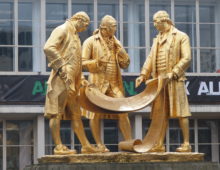Tagged with Napoleon Bonaparte
Resource : Napoleon’s Hat
This hat was worn by the French Emperor Napoleon when he commanded the French Army at the Battle of Waterloo. The hat was a vital part of the image of a hard-working, down-to-earth leader that Napoleon tried to create. His profile was instantly recognisable to French soldiers, most of whom were devoted to him. The red, white and blue cockade, pinned to the hat, is a symbol of the French Revolution.
Resource : The Battle of Vertières
In the late 1700s, the western part (St. Domingue) of the Caribbean island of Hispaniola was under French colonial rule. It had long been a major centre of sugar production on plantations using enslaved African labour. In 1791, Toussaint Louverture led the first – and only – successful uprising of slaves, in St Domingue. After a series of bloody conflicts and traumas with European colonial powers, St Domingue was renamed Haïti and became the first independent Black republic in 1804. These events became known as the Haitian revolution and played an important role in the decline of the Transatlantic slave trade. This lithograph depicts the Battle of Vertières in 1803, the final engagement between Haiti’s revolutionaries and Napoleon’s French forces.
Resource : The Plumb-Pudding in Danger
This print was one of over a thousand satires produced by the celebrated caricaturist, James Gillray, who became known as the ‘father of the political cartoon’. In the 18th century, cartoons and caricatures were a popular way of mocking the establishment and calling them to account. They would be discussed and enjoyed in shop windows, coffee houses and taverns. The arrival of the industrial printing press in the 1800s helped to spread them far and wide, through broadsides (posters), newspapers and pamphlets. This one was inspired by the resumed hostilities and ongoing rivalry between Britain and France in 1805.
Resource : Bonaparte at the Pont d’Arcole, Antoine-Jean Gros
Napoleon rose to power during the French Revolution, crowning himself Emperor of France in 1804. He had ambitions to carve out a vast empire and dynasty, and successfully invaded and conquered countries across the European continent in a series of bloody battles, before he was finally defeated at the Battle of Waterloo in 1815. These became known as the Napoleonic wars.
Resource : Napoleonic coffin relic for sale
September 28, 2018 - The Chairman
This remarkable object has come up for sale and although beyond our pockets is an interesting item. A relic of the exhumation and return of Napoleon I’s mortal remains from St. Helena to France in 1840. It comprises a piece of mahogany from the outer coffin in which the Emperor was interred in 1821, applied with a […]
Resource : French revolutionary and Napoleonic wars (1792-1815)
A series of wars which reconfigured nations and societies within Europe, across the Atlantic, and far beyond, culminating in the legendary Battle of Waterloo.
Resource : War and the international order
The wars precipitated by the struggles for independence and attempts at empire building that characterise the Age of Revolution, and their impact on the changing world map.
Resource : Bust of Jean-Jaques Dessalines (1758 – 1806)
Jean-Jacques Dessalines (1758 – 1806) was born into slavery in St Domingue (now Haiti) on the Caribbean island of Hispaniola. Following a mass uprising of enslaved people of African origin – the only successful slave revolt in history – and a series of bloody battles and reprisals, Dessalines eventually became the first ruler of Haiti, the world’s first modern independent ‘black’ republic. The events in St Domingue became known as the Haitian Revolution.
Resource : Toussaint Louverture, Chief of the French Rebels in St Domingo
Toussaint Louverture (1743 – 1803) was born into slavery in St Domingue (now Haïti) on the Caribbean island of Hispaniola. In 1791 he led the first – and only – successful uprising of enslaved Africans. Although he died before the revolution spawned a nation, in 1804 Haiti became the first independent ‘black’ republic and contributed to the decline of the transatlantic slave trade. The events in St Domingue became known as the Haitian Revolution. This and other depictions of Louverture (in print and portraiture) reflected the high levels of fascination and respect expressed around the world for a radical figure who had refused to yield and who surmounted all foes in the revolutionary contests.
Resource : Russia against Napoleon by Dominic Lieven
March 6, 2017 - The Chairman
Published by Allen Lane and Penguin Books ISBN: 978-0-141-98460-5 This book was put in my Christmas stocking by my wife and she seldom selects books on Military History as he is fed up with books everywhere in this house. I recently finished the book and I must say I have seldom found a book so […]


